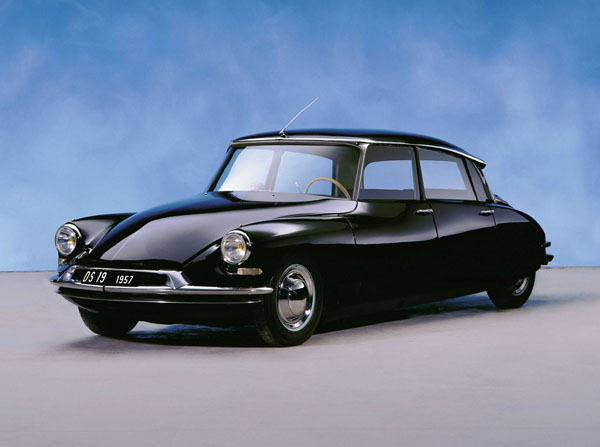
The DS 19 Citroen was in production without fundamental change from 1955 to 1975 and was as far ahead of its time when introduced as the 7CV Traction Avant before it. One of the principal features of this car was the unique hydro-pneumatic suspension system which had the interesting effect of flattening rough roads and enabling ground clearance to be varied from 16.5 cm to 29.5 cm. This same hydro-pneumatic also controlled the DS’s brakes and transmission. After a year the DS19 was joined by the less expensive ID models which broadened the range but lacked power assistance.
The unusual shape and style of the DS19 made the car a scene stealer wherever it went. With its smooth flowing lines it broke the mould that cars before had been constrained by. Gone was the familiar radiator grille from the front of the car to be replaced by a discrete air intake scoop incorporated into the front bumper bar. The two chevrons which, on previous models, stood out front to indicate this was a Citroen moved discretely to the boot lid. The unique styling was sufficient to allow motorists to recognise this marque.
The engine was conventional, but the 1934 long-stroke engine design, retained in most models until 1967, restricted both performance and refinement to a standard not quite in keeping with the rest of the car. Although the cylinder head had been modified, the rest of the 1911 cc four-cylinder in-line OHV front wheel drive unit was unchanged.
The central hydraulic system was driven by an engine-mounted pump which compressed nitrogen gas by means of hydraulic fluid under pressure. This gas pressured oil system operated the car’s power steering, power brakes, the hydraulic gear-change and automatic clutch as well as the hydro-pneumatic system.
An interesting part of the suspension is that it comprised four independent units – one at each wheel – which enabled the car to maintain an even ride-height no matter what load was being carried. A unique advantage of this system was the ability of the car to jack itself up at the touch of a lever. To do this the driver set the suspension to its highest position, placed the provided support under the car and reset the suspension to its lowest.
In 1993, an international automobile publication celebrating 40 years asked motoring journalists from around the world to name the most important car introduced over that period. Needless to say the Citroen DS19 took the honours.








